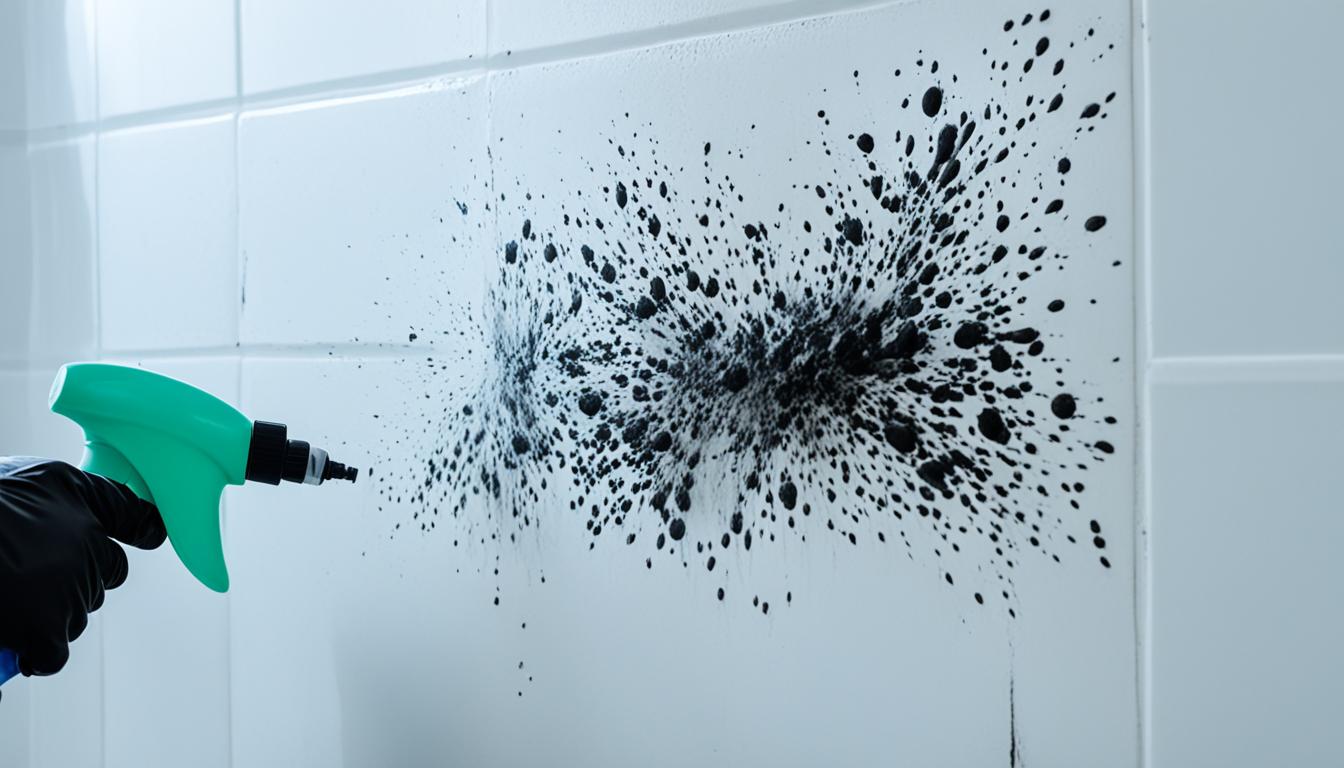Mould is a common problem in homes and can cause damage to the property as well as health issues. To effectively remove mould and prevent its growth, it is important to follow the right mould removal techniques. This section will provide easy steps to get rid of mould and prevent its recurrence.
Mould not only mars the appearance of your home but also poses serious health risks. Effective mould removal techniques are crucial in maintaining a safe and healthy living environment. Whether it’s on your walls, in your bathroom, or in your shower, knowing how to get rid of mould and prevent its growth will give you peace of mind.
From understanding the causes of mould to treating it properly, this guide will equip you with the knowledge and steps you need to take for effective mould removal. Additionally, we will provide you with valuable tips to prevent mould from coming back, ensuring a mould-free home for good.
Understanding the Causes of Mould
Mould growth in homes is a common problem that can lead to property damage and health issues. To effectively tackle mould issues, it is crucial to understand the causes behind its formation. Mould requires specific conditions to grow, namely organic materials, moisture, and oxygen. If these conditions are present, mould can spread rapidly and release airborne spores that can adversely affect human health. Therefore, comprehending the causes of mould is essential in implementing effective mould remediation and prevention methods.
The Role of Moisture and Dampness
One of the key contributors to mould growth is excessive moisture or dampness in indoor environments. Common sources of moisture include leaks, condensation, and high humidity levels. Moisture can accumulate on surfaces such as walls, ceilings, and floors, providing a conducive environment for mould to thrive. Dampness caused by water intrusion or inadequate ventilation can also create favourable conditions for mould growth. Therefore, identifying and addressing underlying moisture issues is crucial in eradicating mould and preventing its recurrence.
Condensation and Its Impact
Condensation occurs when warm air collides with cold surfaces, leading to the formation of water droplets. This phenomenon is commonly observed on windows and mirrors, but it can also occur within wall cavities or behind furniture. Condensation provides moisture that feeds mould growth, making it a significant cause of indoor mould problems. Proper insulation and adequate ventilation can help reduce condensation and limit the conditions for mould growth.
Organic Materials as a Food Source
Mould requires organic materials to sustain its growth. Common sources of organic matter within homes include wood, paper, fabric, and food. When these materials come into contact with moisture, they provide an ideal food source for mould. As the mould feeds on the organic matter, it can deteriorate the material and spread to adjacent areas. Therefore, keeping indoor environments clean and dry, and promptly addressing any water damage or leaks, is vital in preventing mould growth.
To summarize, understanding the causes of mould formation, such as moisture, dampness, condensation, and organic materials, is crucial in implementing effective mould remediation and prevention methods. By addressing these underlying causes, homeowners can eradicate mould from their homes and create a safer, healthier living environment.
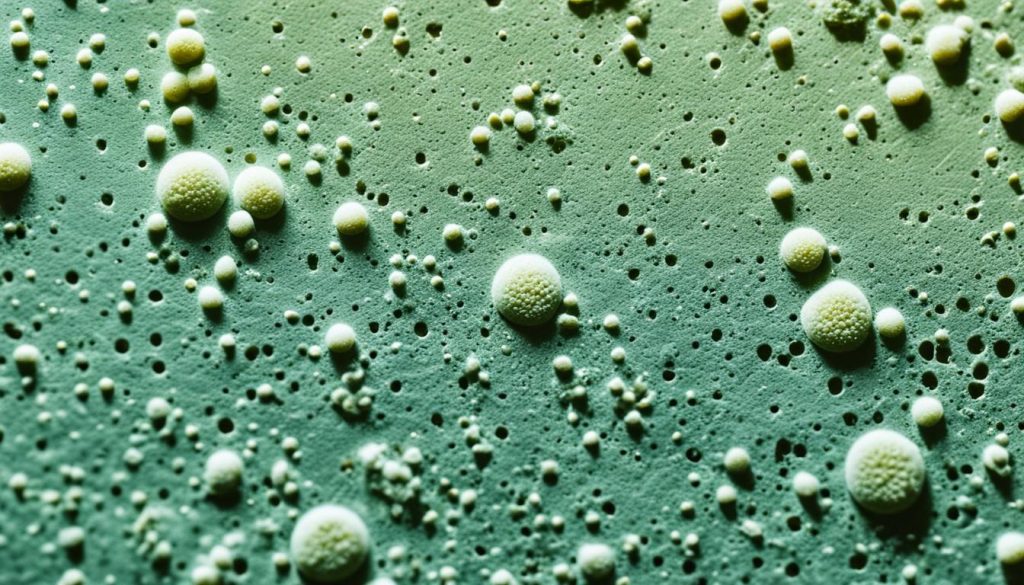
How to Get Rid of Mould?
Mould can be a persistent problem in homes, causing not only unsightly stains but also potential health risks. While temporary cleaning of mould is possible using suitable precautions, it’s important to note that household products are not permanent mould removal treatments. To effectively eliminate mould in the home and ensure it doesn’t come back, it’s essential to follow proper steps for safe mould treatment.
Cleaning Solutions and Protective Gear
When treating mould, wearing protective gear is crucial to minimize exposure to harmful spores. This includes gloves, goggles, and a mask. Additionally, using appropriate cleaning solutions is key to effectively get rid of mould on walls permanently and in shower areas. Vinegar, hydrogen peroxide, or bleach diluted in water can be effective options, but it’s essential to follow the manufacturer’s instructions and ensure proper ventilation during the cleaning process.
Addressing Specific Areas
Some areas in the home are particularly prone to mould growth. Walls, especially those affected by dampness or condensation, require special attention. When treating mould on walls permanently, it’s important to identify and address the underlying cause of moisture to prevent its recurrence. Using a mixture of your chosen cleaning solution and water, carefully scrub the affected area. Don’t forget to dry the walls thoroughly afterward to discourage further mould growth.
Showers are another area commonly affected by mould due to the damp environment. Regular cleaning with specialised bathroom mould cleaners can help get rid of mould in the shower. Pay attention to the grout lines, corners, and edges where mould tends to accumulate. Proper ventilation after showering is also essential to reduce moisture levels and prevent mould growth.
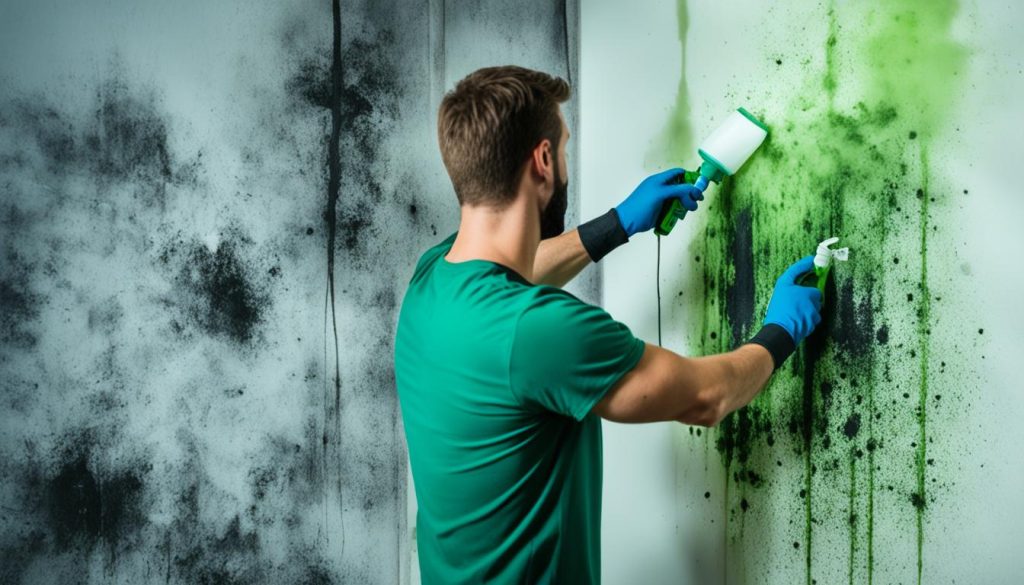
By following these steps, you can effectively treat mould in your home, ensuring a clean and healthy environment. However, it’s important to address the underlying causes of mould to prevent its recurrence. In the next section, we will explore tips for mould prevention to create a mould-free home.
Dealing with Condensation Damp
Condensation damp is a common cause of mould growth in homes. Excess moisture in the air can lead to the formation of condensation, which can accumulate on surfaces such as ceilings and walls. This section will discuss the reasons behind condensation damp and provide practical steps to address the issue, including identifying and repairing sources of moisture, improving ventilation, and using suitable damp prevention measures.
Identifying and Repairing Sources of Moisture
In order to effectively combat condensation damp and prevent mould growth, it is important to identify and repair any sources of moisture. This can include fixing leaking pipes, repairing damaged roof tiles, and sealing any gaps or cracks where water may be seeping into the home.
Improving Ventilation
Good ventilation plays a crucial role in reducing condensation damp. Ensure that rooms are well-ventilated by opening windows, especially in areas prone to moisture such as bathrooms and kitchens. Additionally, consider installing extractor fans in these areas to further enhance airflow.
Using Suitable Damp Prevention Measures
There are several damp prevention measures that can help tackle condensation and prevent mould growth. One effective measure is to use a dehumidifier, which helps to reduce excess moisture in the air. Another option is to use moisture-absorbing products such as silica gel or moisture-absorbing crystals. These can be placed in areas prone to dampness, such as wardrobes or cupboards.
By taking these steps to address condensation damp, you can effectively get rid of mould on ceilings and stop it from coming back on walls. Regular maintenance and vigilance in monitoring moisture levels can help create a healthier and mould-free environment in your home.
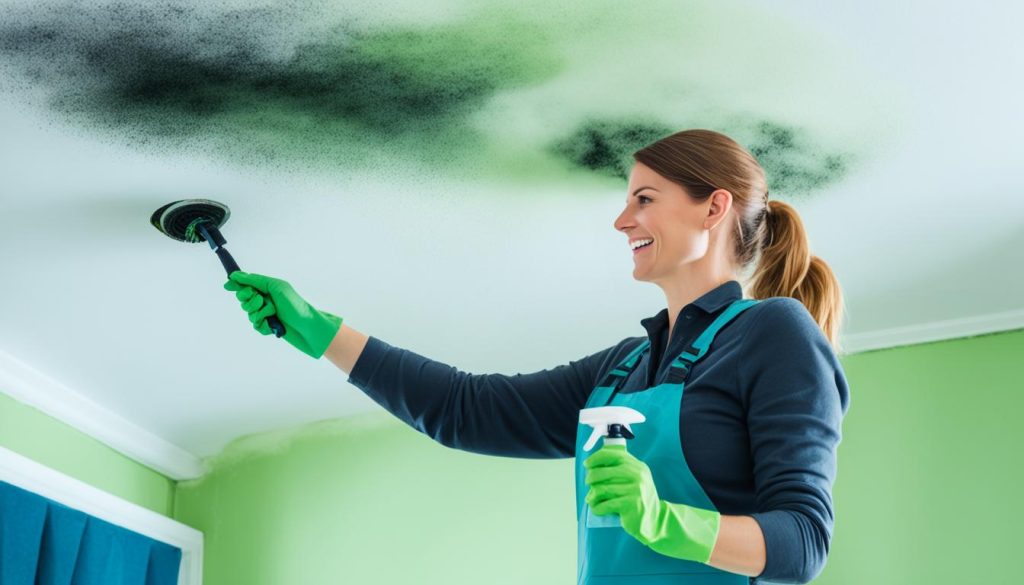
Removing Black Mould
Black mould, such as Stachybotrys Chartarum, poses serious health risks and requires professional removal. If you’re dealing with toxic black mould in your home, follow these three steps to safely clean it off your walls:
Step 1: Gear Up
Before you begin, make sure to protect yourself by wearing appropriate gear, including gloves, goggles, and a face mask. This will shield you from harmful mould spores during the cleaning process.
Step 2: Effective Cleaning Solutions
Choose an effective cleaning solution that is specifically designed to tackle mould. Common options include a mixture of bleach and water, vinegar, or hydrogen peroxide. Apply the solution to the affected areas and scrub gently with a brush or sponge.
Step 3: Remove the Source of Moisture
To prevent black mould from regrowing, it’s crucial to address the source of moisture. Check for any leaks or water damage that may be contributing to mould growth. Fixing these issues will help ensure a mould-free environment.
By following these three steps, you can effectively clean black mould off your walls and take the necessary steps to prevent its recurrence. Remember, if the mould problem is extensive or if you’re unsure about handling it yourself, it’s best to seek professional help to ensure complete removal and the safety of your home.
| Common Misconceptions about Black Mould | The Truth about Black Mould |
|---|---|
| 1. Black mould is harmless. | 1. Black mould can cause severe health issues. |
| 2. Bleach is the best solution for removing black mould. | 2. While bleach can kill mould on non-porous surfaces, it may not be effective on porous materials. |
| 3. Painting over black mould will solve the problem. | 3. Painting over mould will not eliminate it; it will only mask the issue temporarily. |
How to Paint Over Mould?
Painting over mould is not an effective solution to address the underlying cause and can exacerbate the problem. It is essential to remove mould before painting to ensure a lasting solution. To treat damp walls before painting, follow these steps:
- Identify and eliminate the source of moisture: Before painting, it’s crucial to identify and fix any sources of dampness in the walls. This can include repairing leaks, improving ventilation, or addressing condensation issues.
- Prepare the walls: Clean the affected area thoroughly using a solution of water and fungicidal wash. Scrub the surface to remove any mould growth, ensuring that all spores are removed. Rinse the walls with clean water and allow them to dry completely.
- Apply a mould-resistant primer: Once the walls are dry, apply a mould-resistant primer to create a barrier between the wall surface and any potential mould growth. This type of primer helps prevent mould from reappearing and maintains the integrity of the painted surface.
- Use an anti-mould paint: Select a high-quality anti-mould paint that contains fungicides and mold inhibitors. Apply the paint evenly, following the manufacturer’s instructions. This type of paint provides an extra layer of protection against mould growth and helps maintain a clean and healthy environment.
- Regularly monitor and maintain the painted walls: After painting, it’s important to regularly inspect the painted walls for any signs of mould growth. If any mould appears, it should be promptly addressed and treated to prevent further damage.
By following these steps, you can effectively treat damp walls before painting and reduce the risk of mould growth in your home. Remember that proper preparation and using mould-resistant products are key to achieving a long-lasting and mould-free painted surface.
| Benefits of Properly Treating Damp Walls Before Painting |
|---|
| 1. Prevents the spread of mould spores and reduces health risks |
| 2. Ensures a better and longer-lasting paint adhesion |
| 3. Maintains the structural integrity of the walls |
| 4. Enhances the aesthetics of the painted surface |
| 5. Reduces the need for frequent repainting |
Tips for Mould Prevention
Preventing mould growth is essential for maintaining a healthy and mould-free home environment. By taking proactive measures and addressing specific areas prone to mould growth, such as bathrooms and bedrooms, you can effectively combat this problem. Here are some useful tips:
1. Check for Moisture Sources
Mould thrives in damp environments, so it’s important to identify and address any moisture sources in your home. Regularly inspect areas prone to water leakage or condensation, such as pipes, faucets, and windows. Repair any leaks promptly and ensure proper insulation to prevent excess moisture accumulation.
2. Improve Ventilation
Adequate ventilation plays a crucial role in preventing mould growth. Make sure your home is well-ventilated by opening windows, using exhaust fans, or installing ventilation systems, particularly in areas with high humidity, like bathrooms and kitchens. Good airflow helps reduce moisture levels and discourages mould growth.
3. Maintain Proper Humidity Levels
Controlling indoor humidity is key to mould prevention. The ideal humidity level should be below 50%. Use a dehumidifier in areas prone to excessive moisture, regularly emptying and cleaning it to prevent mould growth within the appliance. Additionally, monitor and maintain proper ventilation to help regulate indoor humidity.
By implementing these tips, you can effectively prevent mould growth in your home, ensuring a clean and healthy living environment.
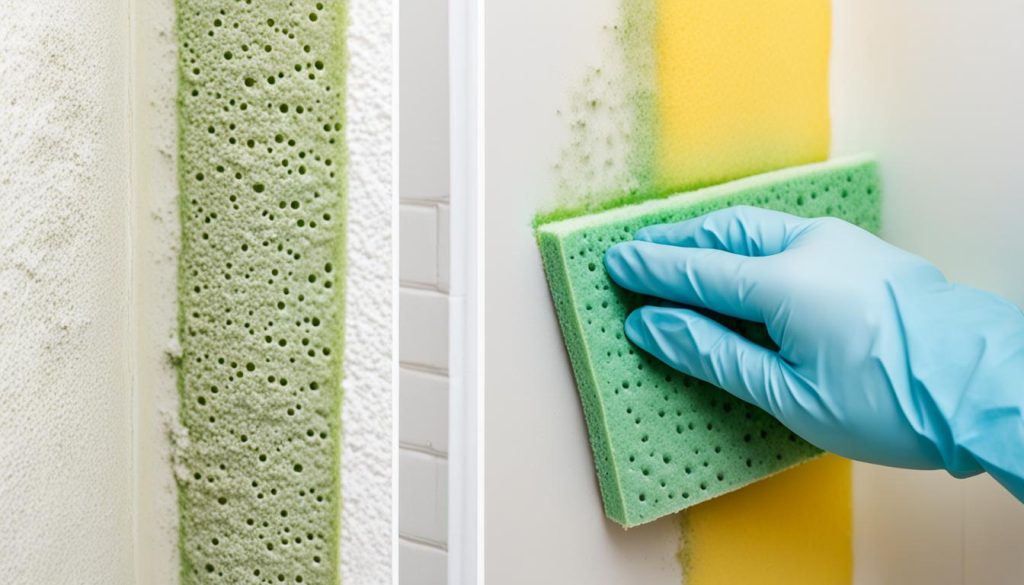
| Area | Mould Prevention Tips |
|---|---|
| Bathroom |
|
| Bedroom |
|
| Walls |
|
Conclusion
Removing and preventing mould in your home is essential for a safe and healthy living environment. By understanding the causes of mould growth, implementing effective removal techniques, and taking preventive measures, you can keep mould at bay permanently.
To remove mould, it’s important to treat it properly using appropriate cleaning solutions and wearing protective gear. However, it’s crucial to remember that household products offer only temporary solutions for mould removal. To prevent mould from coming back, addressing the underlying moisture sources and improving ventilation are key.
Regularly inspecting areas susceptible to mould growth, such as bathrooms and bedrooms, and maintaining proper humidity levels can significantly reduce mould recurrence. Additionally, dealing with condensation damp, a common cause of mould, requires identifying and repairing sources of moisture and using suitable damp prevention methods.
In conclusion, effectively removing and preventing mould involves a comprehensive approach. By following the steps outlined in this article, you can successfully remove mould and keep it away permanently, ensuring a mould-free and healthy living environment for you and your family.

